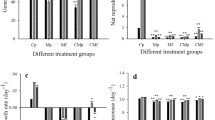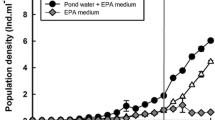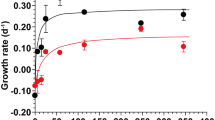Abstract
The population dynamics of B. calyciflorus was investigated using a green alga, Monoraphidium minutum, and a blue-green alga Planktothrix agardhii as food sources, separately and as mixtures. Growth rate (r), egg ratio (ER), and juvenile development time (D j ) were measured in the laboratory and mortality rate and embryonic development time (D E ) were calculated. With M. minutum, Brachionus showed a typical growth curve (‘Monod-kinetics’) dependent on food concentration. In contrast B. calyciflorus did not grow well on P. agardhii. With all food concentrations the measured growth rates were about r=0. At low food concentrations r was low with both food types, but the ER of B. calyciflorus was significantly higher with P. agardhii as food source. Furthermore the relative egg volume of females carrying one egg was higher with Planktothrix than with Monoraphidium. An addition of P. agardhii to M. minutum led to increasing growth rates. Highest growth rates were found with complementary food sources. High food concentrations of M. minutum shortened the juvenile development (D J ) time, but D j was uneffected by different P. agardhii food concentrations. A mixture of both algae did not shorten D j compared with M. minutum as single food. The calculated D E was not effected by different food qualities but the calculated mortality was nearly 3 times higher with P. agardhii as food.
Similar content being viewed by others
References
Bays, J. S. & T. L. Crisman, 1983. Zooplankton and trophic state relationships in Florida lakes. Can. J. Fish. aquat. Sci. 40: 1813–1819.
Bennett, W. N. & M. E. Bomas, 1989. An experimental test of the egg-ratio method with instantaneous birth rate as an independent variable. Limnol. Oceanogr. 34: 1120–1125.
Burns, C. W., D. J. Forsyth, J. F. Haney, M. R. James, W. Lampert & R. D. Pridmore, 1989: Coexistence and exclusion of zooplankton by Anabaena minutissima var. attenuata in Lake Rotongaio, New Zealand. Arch. Hydrobiol. Beih. 32: 63–82.
Chow-Fraser, P. & W. G. Sprules, 1986. Inhibitory effects of Anabae-na sp. on in situ filtering rate of Daphnia. Can. J. Zool. 64: 1831–1834.
de Bernardi, R. & G. Guissani, 1990. Are blue-green algae a suitable food for zooplankton? An overview. Hydrobiologia 200/201 (Dev. Hydrobiol. 61): 29–41.
Edmondson, W. T., 1965. Reproductive investment of planktonic rotifers as related to food and temperature. Ecol. Monogr. 35: 61–111.
Fulton, R. S., 1988. Grazing on filamentous algae by herbivorous zooplankton. Freshwat. Biol. 20: 263–271.
Gilbert, J. J., 1990. Differential effects of Anabaena affinis on cladocerans and rotifers: Mechanisms and implications. Ecology 71: 1727–1740.
Gilbert, J. J. & K. G. Bogdan, 1984. Rotifer grazing: In situ studies on selectivity and rates. In D. G. Meyers & J. R. Strickler, (eds), Trophic interactions within aquatic systems. Vol. 85. AAAS Selected Symposium: 97–133.
Gilbert, J. J., 1994. Susceptibility of planktonic rotifers to a toxic strain of Anabaena flos-aquae. Limnol. Oceanogr. 39: 1286–1297.
Gliwicz, Z. M., 1990. Why do cladocerans fail to control algal blooms? Hydrobiologia 200/201 (Dev. Hydrobiol. 61): 83–97.
Gliwicz, Z. M. & W. Lampert, 1990. Food threshold in Daphnia species in the absence and presence of blue-green filaments. Ecology 71: 691–701.
Gulati, R. D., J. Ejsmont-Karabin & G. Postema, 1993. Feeding in Euchlanis dilatata lucksiana Hauer on filamentous cyanobacteria and a prochlorophyte. Hydrobiologia 255/256 (Dev. Hydrobiol. 83): 269–274.
Hartmann, H. J., 1985. Feeding of Daphnia pulicaria and Diaptomus ashlandi on mixtures of unicellular and filamentous algae. Verb. int. Ver. Limnol. 22: 3178–3183.
Herzig, A., 1983. Comparative studies on the relationship between temperature and embryonic development in rotifers. Hydrobiologia 104 (Dev. Hydrobiol. 14): 237–246.
Lotka, A. J., 1922. The stability of the normal age distribution. Proc. natn.nam. Acad. Sci. U.S.A. 8: 339–345.
Müller, H., 1972. Wachstum and Phophatbedarf von Nitzschia actinastroides (LEMM.) v.GOOR in statischer and homokontinuierlicher Kultur unter Phosphatlimitierung. Arch. Hydrobiol./Suppl. 38: 399–484.
Paloheimo, J. E., 1974. Calculation of instantanous birth rates. Limnol. Oceanogr. 19: 692–694.
Porter, K. G. & J. D. Orcutt, 1980. Nutritional adequacy, manageability, and toxicity as factors that determine the food quality of green and blue-green algae for Daphnia. W. C. Kerfoot (ed.), Ecology and Evolution in Zooplankton Communities. The University Press of New England, Hanover, (N.H.); Lond.: 268–281.
Rothhaupt, K. O., 1990. Population growth rates of two closely related rotifer species: effects of food quantity, particle size, and nutritional quality. Freshwat. Biol. 23: 561–570.
Rothhaupt, K. O., 1991. The influence of toxic and filamentous blue-green algae on feeding and population growth of the rotifer Brachionus rubens. Int. Revue ges. Hydrobiol. 76: 67–72.
Ruttner-Kolisko, A., 1977. Suggestions for biomass calculation of planktonic rotifers. Arch. Hydrobiol. Beih. 8: 71–76.
Snell, T. W., C. J. Bieberich & R. Fuerst, 1983. The effects of green and blue-green algal diets on the reproductive rate of the rotifer Brachionus plicatilis. Aquaculture 31: 21–30.
Starkweather, P. L., 1981. Trophic relationships between the rotifer Brachionus calyciflorus and the blue-green alga Anabaena flos-aquae. Verb. int. Ver. Limnol. 21: 1507–1514.
Starkweather, P. L. & P. E. Kellar, 1983. Utilization of cyanobacteria by Brachionus calycifiorus: Anabaena flos-aquae (NRC-44–1) as a sole or complementary food source. Hydrobiologia 104 (Dev. Hydrobiol. 14): 373–377.
Starkweather, P. L. & P. E. Kellar, 1987. Combined influences of particulate and dissolved factors in the toxicity of Microcystis aeruginosa (NRC-SS-17) to the rotifer Brachionus calyciflorus. Hydrobiologia 147 (Dev. Hydrobiol. 42): 375–378.
Vareschi, E. & J. Jacobs, 1984. The ecology of Lake Nakuru (Kenya): V. Production and consumption of consumer organisms. Oecologia 61: 83–98.
Walz, N. & F. Rothbucher, 1991. Effects of food concentration on body size, egg size and population dynamics of Brachionus angularis (Rotatoria). Verb. int. Ver. Limnol. 24: 2750–2753.
Author information
Authors and Affiliations
Rights and permissions
About this article
Cite this article
Weithoff, G., Walz, N. Influence of the filamentous cyanobacterium Planktothrix agardhii on population growth and reproductive pattern of the rotifer Brachionus calyciflorus . Hydrobiologia 313, 381–386 (1995). https://doi.org/10.1007/BF00025974
Issue Date:
DOI: https://doi.org/10.1007/BF00025974




